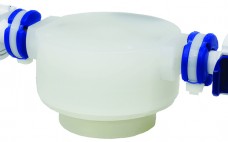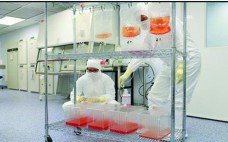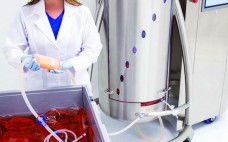The rapid spread of contagious and lethal diseases worldwide has driven bioprocess suppliers to develop technologies for use in producing disease treatments and vaccines. Bioprocessors need to develop new biologics as well as rapid and reliable methods for bringing those treatments to commercialization. Implementing modular process solutions and single‑use handling systems in closed‑manufacturing processing is one approach to addressing those needs. Developing and discovering solutions for meeting global healthcare conditions is an evolving part of bioindustry. As points of reference,…
Single Use
Quantitative Risk Assessment of Bioaccumulation Attributable to Extractables and Leachables in Cellular Immunotherapy Biomanufacturing
Precious patient samples, contamination concerns, and limited product purification options have compelled manufacturers of cellular immunotherapies (iTx) such as chimeric antigen receptor T cells (CAR-T) and T-cell receptor (TCR) technologies toward the disposables industry. Such companies are implementing single-use technologies (SUTs) almost exclusively (1). But despite the dominance of disposable bioprocess platforms and their extraordinary growth in the iTx marketplace, researchers have made limited efforts to understand the perennial and critical bioprocessing risks of leachables and extractables. Here we outline…
Management, Notification, and Documentation of Single-Use Systems Change Orders: Challenges and Opportunities
Single-use systems (SUS) consist of numerous plastic components derived from different suppliers. As such, they are prone to changes, including alterations in construction materials or modifications in manufacturing processes. Such changes may originate at the immediate supplier or farther back in the supply chain as a result of product improvements, process improvements, part discontinuation, or even business decisions such as manufacturing site relocation. Whether those changes are major or minor, managing their impact on biopharmaceutial processes and product quality often…
Positioning for Success: An Interview with Mario Philips
On 12 March 2015, BPI met with Mario Philips, president, single-use technologies, at Pall’s Port Washington, NY, facility, to learn about Pall’s reasons for entering the cell therapy market. Also participating in the discussion was Alain Fairbank, director of marketing for cell therapies at Pall Life Sciences. Read the full text of this article in the PDF (Login required).
Meeting Lot-Size Challenges of Manufacturing Adherent Cells for Therapy
Adherent cells such as adult primary cell lines and human multipotent (MSCs) and pluripotent stem cells (hPSCs) present a manufacturing challenge as lot sizes increase from 109 (billions) to 1012 (trillions) cells (1). Typically, manufacturing platforms are good for one log of expansion. So new methods will be required to achieve commercially relevant lot sizes. Traditional two-dimensional culture methods have been used to grow anchorage-dependent cell types. Although such methods are reliable and well defined, they are very labor intensive…
Choosing Between Single-Use and Multiuse Technologies: A BPI Theater Roundtable at Interphex 2015
On Tuesday, 21 April 2015, Eric S. Langer (managing partner at BioPlan Associates) chaired a midday roundtable titled, “Deciding on Single-Use vs. Stainless Steel Bioprocessing Strategy: What Do CMOs Know That Biopharmas Don’t?” Langer brought together these industry experts to discuss choosing between stainless steel and single-use technologies (SUTs) for different applications: William Hartzel (director of strategic execution at Catalent Pharma Solutions) Steven Perry (vice president of technical operations at Cook Pharmica) Joanna Pezzini (bioprocess engineer at MedImmune) Daniel Vellom…
Single-Use Technologies: BIO Theater @ Interphex 2015
Andrew Lidums (NA business development manager, Parker domnick hunter) 2:30–2:55 pm Implementing a Risk-Management–Based Approach to the Prevention of Mycoplasma Contaminations Lidums began with a recent report from Genentech, where a 150-µm long Leptospira organism from a drainage ditch outside the facility managed to penetrate 0.1-µm filters. The company solved this problem by lowering the temperature of the filtration operation, which made the bacteria more rigid and kept them from getting through. Clearly, however, contaminations happen even at large facilities.…
Toward Industry Standardization of Extractables Testing for Single-Use Systems: A Collective BPSA Perspective
Here we present a consensus position of the membership of the Bio-Process Systems Alliance (BPSA), the trade organization for the single-use industry based in Washington, DC. BPSA’s membership includes 48 corporate and institutional entities, among them component suppliers, systems integrators, end users, and independent testing laboratories. Consensus within this membership is reached through an official ballot of representative voting members, as provided for in the organization’s by-laws. The position outlined below was approved by such an internal consensus-balloting process. Building…
Extractables Profiles: A Comprehensive Approach Produces Long-Term Results
Biopharmaceutical manufacturers spend years developing and testing new drug and biologic products to ensure their efficacy, safety, and usability for patients. Such knowledge is extremely valuable, but those same principles often get overlooked in selection of packaging and delivery systems. Decisions on packaging and delivery often are made almost as an afterthought. However, issues related to components such as extractables and leachables can affect patient safety and product quality. In addition, a lack of extractables and leachables data in filings…
The New Hybrid: Single-Use Systems Enabled By Process Automation
Much has been written in recent years about the union of single-use systems (SUS) and process automation. These two technology initiatives have been prevalent within biopharmaceutical manufacturing over the past decade and are two of the most predominant advancements in biomanufacturing. A basic survey of industry media and conference topics corroborates that premise (1). However, efforts to combine them remain in the early stages of technological fulfillment, with much work to be done in realizing their synergistic benefits. Here I…









